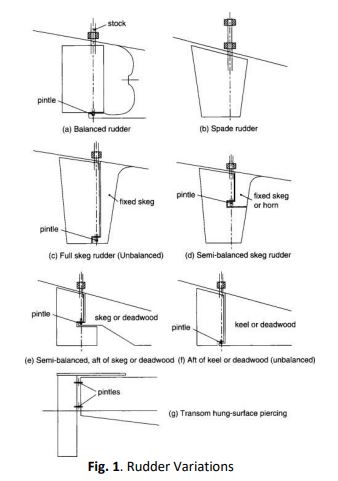Comparative Study of Rudder Performance of Single Plate and Fishtail of SPOB Ship Using CFD Method
DOI:
https://doi.org/10.37934/cfdl.14.5.4355Keywords:
Rudder, Fishtail, CFD, Self Propeller Oil BargeAbstract
Rudder is the most important hydrodynamic control surface on a ship to control horizontal movement. An important function of the rudder is to develop a force concerning orientation and motion relative to the water. The widely used type is the conventional type. However, the other types of rudders, other than the conventional type, are the single plate and fishtail types. This study aims to analyze the difference in performance between the single plate rudder on the Adeline 01 spob (self propeller oil barge) ship and the fishtail rudder on the value of lift force and drag force as well as find out the comparison of the two Rudders on the maneuvering force of the Adeline 01 spob ship. The method used was the Clark equation with the help of a CFD-based application to determine the performance of the ship lifts force and drag force by varying the turning angle by 5°, 10°, 15°, 20°, 25°, and 30°. The results obtained from this study was the Fishtail has better maneuverability at 5° and 10° angle variations with lift coefficient values of 0.0398 and 0.0522, and with Steady Turning Diameter (STD) values of 1882.9 m and 717.83 m. On another hand, the Single Plate rudder has better maneuverability at angle variations of 15° and 20° with lift coefficient values of 688.30 m and 330.77 m, and with STD values of 688.30 m and 330.77 m. At the angle variations of 25° and 30°, Rudder Fishtail has better maneuverability with lift coefficient values of 0.7712 and 0.9993, and with Steady Turning Diameter (STD) values of 53.40 m and 35.92 m
Downloads
References
Singh, Yogang, S. K. Bhattacharyya, and V. G. Idichandy. "CFD approach to modelling, hydrodynamic analysis and motion characteristics of a laboratory underwater glider with experimental results." Journal of Ocean Engineering and Science 2, no. 2 (2017): 90-119. https://doi.org/10.1016/j.joes.2017.03.003
Harvald, Svend Aage. Resistance and propulsion of ships. 1992.
Nair, Vinod V., and S. K. Bhattacharyya. "Water entry and exit of axisymmetric bodies by CFD approach." Journal of Ocean Engineering and Science 3, no. 2 (2018): 156-174. https://doi.org/10.1016/j.joes.2018.05.002
Rumapea, Marsaut Maurit, Deddy Chrismianto, and Parlindungan Manik. "Pengaruh Penambahan Fin Pada Rudder Untuk Mengurangi Hambatan Kemudi Kapal Dengan Metode Cfd (Studi Kasus Kapal Kriso Container Ship)." Jurnal Teknik Perkapalan 4, no. 2 (2016).
Sulisetyono, Aries. "Development of a ‘Fish Tail’Rudder to Improve a Ship’s Maneuverability in Seaway." IPTEK Journal of Proceedings Series 1, no. 1 (2014). https://doi.org/10.12962/j23546026.y2014i1.376
Doustdar, M. Mehdi, and Hamid Kazemi. "Effects of fixed and dynamic mesh methods on simulation of stepped planing craft." Journal of Ocean Engineering and Science 4, no. 1 (2019): 33-48. https://doi.org/10.1016/j.joes.2018.12.005
Hutapea, Reinhard Fernando, Parlindungan Manik, and Untung Budiarto. "Analisa Pengaruh Penambahan Fin Pada Rudder Terhadap Kemampuan Manuvering Kapal Dengan Menggunakan Metode Computational Fluid Dynamic (Studi Kasus Kriso Container Ship)." Jurnal Teknik Perkapalan 5, no. 4 (2017).
Zheng, Yisong, Xiuguo Zhang, Zijing Shang, Siyu Guo, and Yiquan Du. "A decision-making method for ship collision avoidance based on improved cultural particle swarm." Journal of Advanced transportation 2021 (2021). https://doi.org/10.1155/2021/8898507
Badshah, Mujahid, Saeed Badshah, and Sakhi Jan. "Comparison of computational fluid dynamics and fluid structure interaction models for the performance prediction of tidal current turbines." Journal of Ocean Engineering and Science 5, no. 2 (2020): 164-172. https://doi.org/10.1016/j.joes.2019.10.001
Bi, Xiu-ying, and XianJie Liu. "Research on double collision avoidance mechanism of ships at sea." TransNav: International Journal on Marine Navigation and Safety of Sea Transportation 9, no. 1 (2015): 13-16. https://doi.org/10.12716/1001.09.01.01
U. Budi, “Peranan Baling Baling pada Gerakan Kapal,” Teknik, vol. 33, no. 2, pp. 106–111, 2012.
Klaas Van Dokkum, “Ship Knowledgea Modern Encyclopedia.” p. 400, 2016.
Riesner, Malte, and Ould el Moctar. "Assessment of wave induced higher order resonant vibrations of ships at forward speed." Journal of Fluids and Structures 103 (2021): 103262. https://doi.org/10.1016/j.jfluidstructs.2021.103262
W. W. Massie, “OFFSHORE HYDROMECHANICS First Edition,” Currents, no. January, 2001.
Birk, Lothar. Fundamentals of Ship Hydrodynamics: Fluid Mechanics, Ship Resistance and Propulsion. John Wiley & Sons, 2019. https://doi.org/10.1002/9781119191575
Subramaniam, Thineshwaran, and Mohammad Rasidi Rasani. "Pulsatile CFD Numerical Simulation to investigate the effect of various degree and position of stenosis on carotid artery hemodynamics." Journal of Advanced Research in Applied Sciences and Engineering Technology 26, no. 2 (2022): 29-40. https://doi.org/10.37934/araset.26.2.2940
Abobaker, Mostafa, Sogair Addeep, Lukmon O. Afolabi, and Abdulhafid M. Elfaghi. "Effect of Mesh Type on Numerical Computation of Aerodynamic Coefficients of NACA 0012 Airfoil." Journal of Advanced Research in Fluid Mechanics and Thermal Sciences 87, no. 3 (2021): 31-39. https://doi.org/10.37934/arfmts.87.3.3139
Ali, Jaffar Syed Mohamed, Mohd Farid Amran, and Nurul Aziz Mohamad. "Experimental Study on the Effect of Boundary Layer Control on the Aerodynamics Characteristics of NACA 0021 Aerofoil." Journal of Advanced Research in Fluid Mechanics and Thermal Sciences 94, no. 1 (2022): 129-137. https://doi.org/10.37934/arfmts.94.1.129137




























